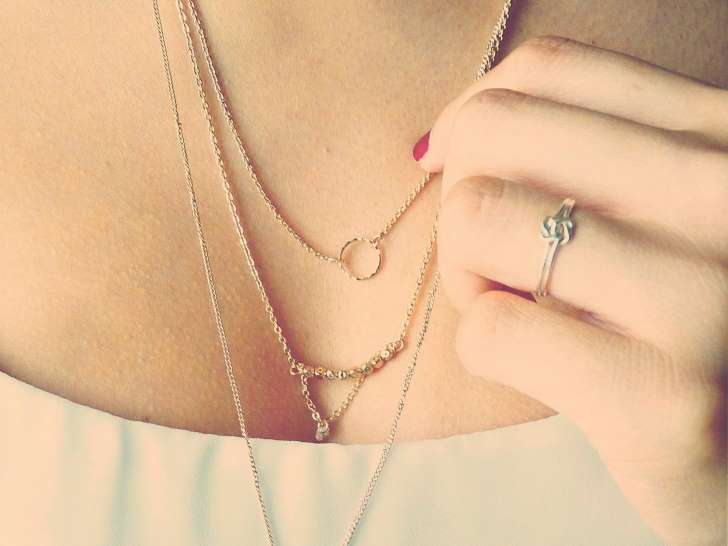It’s almost impossible for me to shop at stores like Zara or Forever 21 without scouring the jewelry racks for a new ring, necklace, or pair of earrings. But after wearing cheap (but cute) costume jewelry, I get dry patches on my earlobes or a rash on the back of my neck. After an appointment with Dr. Google, I suspect my reactions are caused by a nickel allergy, a common condition that many people have, according to Melissa Kanchanapoomi Levin, M.D., a board-certified NYC dermatologist and clinical attending at NYU and Mount Sinai Hospital.
If you’ve been dealing with similar breakouts and you think your jewelry could be the cause, read on to learn how to protect your skin from a nickel-induced rash.
What does a nickel allergy look like?
Nickel is one of the most common causes of allergic contact dermatitis, a skin reaction caused by exposure to a specific allergen. It can look like a red, itchy rash, dry patches of skin that look like a burn, or blisters and other bumps. Since nickel can be found in clothing, electronics, certain makeup, jewelry, and even foods, you may notice a reaction in many different areas on your body—like itchy ears after wearing earrings, a hand rash from handling keys, or a belly-button irritation from a button on your pants. If you’re not sure what’s causing your symptoms, see a dermatologist or allergist to get an official diagnosis.
If you have a nickel allergy, here’s what you need to know.
1. The only truly nickel-free jewelry is made with 100 percent pure metals, like stainless steel, platinum, or gold.
If you are diagnosed with a nickel allergy, it’s important to avoid the metal as much as possible—which is easier said than done, since, as we mentioned above, it shows up in lots of products and it’s hard to always know if something contains nickel. For example, while certain jewelry may be described as gold plated or nickel free, these pieces can still contain nickel alloys or a mixture of metals underneath the surface, according to Lily Talakoub, M.D., of McLean Dermatology and Skincare Center. Even things that read 14K or 18K gold are not completely safe for those with an allergy. “The K stands for karat, which refers to the percentage of gold in an alloy,” says Dr. Levin. “24K is 100 percent gold, 18K is 75 percent gold and 25 percent alloyed metals, and 14K is 58 percent gold and 42 percent alloyed meals. Alloyed metals can contain nickel, so 14K gold or gold-plated jewelry can still cause allergic reactions.” For those with nickel allergies, purchasing pieces made with surgical-grade stainless steel, platinum, pure sterling silver, or 24K yellow gold will help ensure that your jewelry won’t cause a reaction on your skin. Bonus: The jewelry will also last a lot longer than cheap jewelry.
2. Clear nail polish can act as a barrier against the irritants found in costume jewelry.
Although experts advise against wearing costume jewelry if you’re allergic to nickel, it can be hard to pass up some cute pieces—especially when they’re super affordable. “If you don’t want (or can’t buy) real jewelry, I would recommend lining the back of any jewelry you wear with three coats of clear nail polish, which limits the amount of irritants that are released on the skin from body heat and sweat,” says Dr. Talakoub. After a few wears of the jewelry, make sure to re-apply the polish to continue to protect skin.
3. You can test for nickel ingredients in your jewelry at home.
Dr. Levin tells her patients who have an allergy to purchase an over-the-counter dimethylglyoxime spot test ($19), which can detect nickel in any jewelry. That way you’ll be in a better position to guard against possible flare-ups. “Put two to three drops onto a cotton-tipped applicator and firmly rub on the object for approximately five seconds,” she says. “ If nickel is present, the swab will turn pink.”
4. Breakouts from a nickel allergy can be treated with over-the-counter products.
If you develop a reaction after wearing costume jewelry, visit a dermatologist to confirm that a nickel allergy is what’s causing it. Most of the time, you can treat a nickel allergy using a topical corticosteroid on the affected area, like Cortizone 10 ($6), which will help reduce redness and swelling. You should also apply a protective moisturizer, such as Aquaphor Healing Ointment ($15), to protect the area from further irritation. If your reaction is really bad, you can also use an antihistamine medication, like Benadryl ($13). If the symptoms persist, visit your dermatologist to get a prescription treatment.












